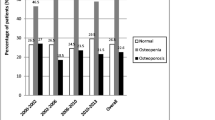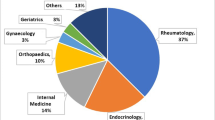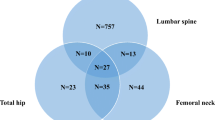Abstract
Summary
We investigated the reasons for referral of older Australians aged 70 years and older to dual energy X-ray absorptiometry (DXA). The most common clinical indication was being aged 70 years and older, followed by monitoring for fracture or low bone mineral density (BMD). Compared to males, females were twice as likely to have osteoporotic BMD.
Purpose/Introduction
Little is known about reasons for the referral of older Australians to dual energy X-ray absorptiometry (DXA) for bone mineral density (BMD) measurements. Thus, we aimed to document the reasons for referral to DXA in Australian men and women aged 70 years and older and investigate any differences between the sexes.
Methods
Reasons for DXA referral were examined in 5438 patients aged ≥70 years (78.5 % female), referred to the Geelong Bone Densitometry Service, south-eastern Victoria, 2003–2010. Clinical indication codes derived from patient records were used to ascertain reasons for referral. We ascertained age, sex and BMD measures at the femoral neck and spine for each patient.
Results
The most common reason for DXA referral was being aged ≥70 years (64.6 %), followed by monitoring of fracture or low BMD. In this referred population, a greater proportion of men than women had BMD in the normal range (men 30.2 % vs. women 10.9 %, p < 0.001), whereas sex differences in the opposite direction were seen for BMD in the osteopenic range (women 47.7 % vs. men 44.3 %, p = 0.04) and in the osteoporotic range (women 41.4 % vs. men 25.5 %, p < 0.001). After age adjustment, women were twice as likely to have BMD in the osteoporotic range compared to men (odds ratio (OR) 2.25, 95% confidence interval (95%CI) 1.95–2.61).
Conclusion
For both sexes, the most common reason for referral was being aged 70 years or older. Referred women were twice as likely as men to have BMD in the osteoporosis range. These data suggest that even more women may need to be referred to DXA.
Similar content being viewed by others
References
Pasco JA, Seeman E, Henry MJ, Merriman EN, Nicholson GC, Kotowicz MA (2006) The population burden of fractures originates in women with osteopenia, not osteoporosis. Osteoporos Int 17:1404–1409
WHO (2007) Prevention and management of osteoporosis: report of a WHO scientific group. In. World Health Organisation Scientific Group on the prevention and management of osteoporosis
Watts J, Abimanyi-Ochom J, Sanders KM (2013) Osteoporosis costing all Australians: a new burden of disease analysis—2012 to 2022. In. Osteoporosis Australia, Glebe, NSW
Pasco JALS, Brennan SL, Timney EN, Bucki-Smith G, Dobbins AG, Nicholson GC, Kotowicz MA (2014) Fracture risk among older men: osteopenia and osteoporosis defined using cut-points derived from female versus male reference data. Osteoporos Int 25:857–862
Henry MJ, Pasco JA, Nicholson GC, Kotowicz MA (2011) Prevalence of osteoporosis in Australian men and women: Geelong Osteoporosis Study. Med J Aust 195:321–322
Kiebzak GM, Beinart GA, Perser K, Ambrose CG, Siff SJ, Heggeness MH (2002) Undertreatment of osteoporosis in men with hip fracture. Arch Int Med 162:2217–2222
Otmar R, Henry MJ, Kotowicz MA, Nicholson GC, Korn S, Pasco JA (2011) Patterns of treatment in Australian men following fracture. Osteoporos Int 22:249–254
Ebeling PR (1998) Osteoporosis in men. New insights into aetiology, pathogenesis, prevention and management. Drugs Aging 13:421–434
WHO (1994) Assessment of fracture risk and its application to screening for postmenopausal osteoporosis. In. World Health Organisation, Geneva, Switzerland
(2006) Medicare Services Advisory Committee: An application for increasing the availability for bone mineral densitometry (BMD) testing to at-risk groups by Osteoporosis Australia. In. Osteoporosis Australia, p 45
Brennan SL, Kotowicz MA, Sarah B, Leslie WD, Ebeling WD, Metge CJ, Dobbins AG, Pasco JA (2013) Examining the impact of reimbursement on referral to bone density testing for older adults: 8 years of data from the Barwon Statistical Division, Australia. Arch Osteoporos 8:152
ABS (2006) Australian Bureau of Statistics, Socio-economic Indices for Areas [SEIFA] - technical paper. In. ABS, Canberra
Henry MJ, Pasco JA, Sanders KM, Kotowicz MA, Nicholson GC (2008) Application of epidemiology to change health policy: defining age-related thresholds of bone mineral density for primary prevention of fracture. J Clin Densitom Assess Skel Health 11:494–497
Torpy AMJ, Brennan SL, Kotowicz MA, Pasco JA (2012) Reasons for referral to bone densitometry in men and women aged 20–49 years: population-based data. Arch Osteoporos 7:173–178
van Staa TP, Leufkens HG, Cooper C (2002) The epidemiology of corticosteroid-induced osteoporosis: a meta-analysis. Osteoporos Int 13:777–787
Henry MJ, Pasco JA, Korn S, Gibson JE, Kotowicz MA, Nicholson GC (2010) Bone mineral density reference ranges for Australian men: Geelong Osteoporosis Study. Osteoporos Int 21:909–917
Acknowledgments
SLB is the recipient of a National Health and Medical Research Council (NHMRC) of Australia Early Career Fellowship (GNT1012472). LJW is supported by a NHMRC of Australia Career Development Fellowship (GNT1064272). LJW, MAK and JAP have received project funding from the NHMRC.
Conflicts of interest
AG Dobbins, SL Brennan, LJ Williams, B Sarah, and JA Pasco have no conflict of interest. MA Kotowicz is the Director of the Geelong Bone Densitometry Service, Australia. Y Birch is employed by the Geelong Bone Densitometry Service, Australia, as a Senior Technician.
Author information
Authors and Affiliations
Corresponding author
Rights and permissions
About this article
Cite this article
Dobbins, A.G., Brennan, S.L., Williams, L.J. et al. Who are the older Australians referred for a bone density scan? Data from the Barwon region. Arch Osteoporos 9, 196 (2014). https://doi.org/10.1007/s11657-014-0196-x
Received:
Accepted:
Published:
DOI: https://doi.org/10.1007/s11657-014-0196-x




